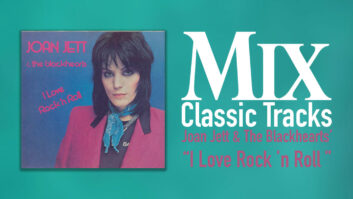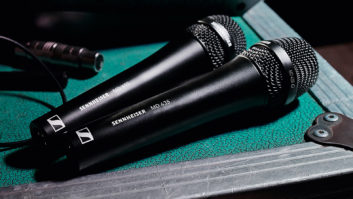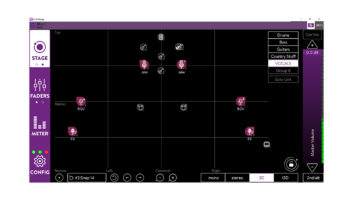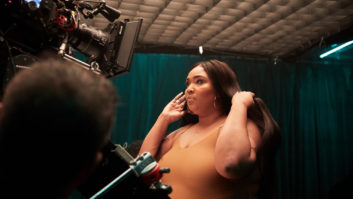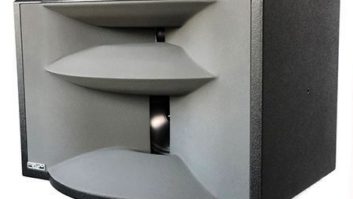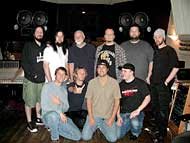

CALLING ALL ANGELS
San Francisco’s motley music community doesn’t have a genre-specific scene like Seattle, Nashville or Minneapolis; however, the city known for diversity and self-expression claims talented acts of many styles, from hard rock to jazz to avant-garde instrumental music. “San Francisco is more open to creating wilder things, where L.A. is about getting work done,” says producer/engineer Matt Wallace. “There’s more of a joie de vivre in S.F. — anything can happen.”
Mudvayne and crew take a break at The Plant. Front row from left: John Eaton, Ryan Martinie, Jonathan Cahen and assistant engineer Mike Boden. Back row: Chad Gray, Greg Tribbett, studio owner Arne Frager, producer Dave Fortman, engineer Jeremy Parker and Matt McDonough
Photo: Greg Waterman
Certainly, anything can happen in the music biz, including a major bout of housecleaning. If a studio was gasping for air during the late ’90s dotcom madness, the ensuing September 11, 2001, terrorist attacks suffocated it. With less big label money floating around, artists retreated further into their home studios and pondered life as a D.I.Y. artist. Meanwhile, studios determined to survive hunkered down and found new ways to accommodate their clients.
Hyde Street has turned every inch of available space — lounges, bathrooms, you name it — into Pro Tools editing suites. On a related note, Paul Stubblebine moved out of his Hyde Street space and into the former Coast Recorders building in 2002, retrieving its original name after Philip Steir and Craig Silvey put the last slab of butter on Toast. “Coast is run by several people now and there’s sessions every day back there,” Stubblebine says.
Over in Sausalito, Studio D replaced its Amek 9098i with a Digidesign ProControl and Pro Tools|HD system this year. “As music changed over the years, so did the demands of the room,” says co-owner Joel Jaffe. Producer/Talking Head Jerry Harrison, for example, often visits Studio D and The Plant to track and then returns to his own nearby studio, Sausalito Sound, to overdub and mix.
On day one of 2000, The Plant’s facility expanded to include The Plant Mastering, which is run by John Cuniberti. Clients include major-label acts such as Tracy Chapman, the Neville Brothers and the Funky Meters, and locals such as Essence, DJ Shadow, Lyrics Born and others for local hip hop label Quannum Records. In an effort to woo artists out of their home studios, The Plant also redesigned its Studio A for live tracking and added an SSL 9000 J.
In 2001, Carmer teamed with Third Eye Blind to open Morningwood Studios. He’s also finishing up his Berkeley home studio, designed by Chris Pelonis with Rick Ruzzamenti and Bullseye Builders, and armed, like Morningwood, with a Helios console.
Feeling the effects of the more remote, workstation-driven recording process, Howard Johnston and Susan Skaggs sold Different Fur to indie label Klepto Records. “A band could come in and I wouldn’t hear a lick of music,” says Skaggs of her reason to sell. “The job just didn’t seem that creative anymore.” Skaggs says she was “never happier” than during her years in the studio biz, but recently moved into a new home in San Diego, Calif., and is pursuing a real estate license. Johnston, who now works as an independent engineer, works mostly at SF Soundworks, which opened its doors last year.
As the recording industry dusts itself off and gets used to new business models, San Francisco shows promising signs of growth. The Donnas caught mainstream attention with their Plant/Fantasy-recorded, Jason Carmer — produced album, Spend the Night, on Lookout Records. John Vanderslice praises 21-year-old harpist Joanna Newsom, while Cuniberti compliments singer/songwriters Beth Waters and Michael Joy. Other local luminaries include Soulsides offshoots Lyrics Born, Latyrx and Blackalicious, alternative act Essence and mainstays such as Chris von Sneidern and Chuck Prophet, both 20-year vets of the S.F. scene who continue to release good work.
Mark Needham and former 415 Records founder Jeff Saltzman opened a new East Bay studio this year and have developed acts such as The Killers, The Lovemakers (Interscope) and Drama (Fierce Panda). Carmer just finished a couple of songs for The Peels for Dim-Mak/Capitol. SF Soundworks president Tony Espinoza works closely with local bands such as Rogue Wave (SubPop) and Strata (Windup Records). On a broader level, the Recording Academy’s San Francisco chapter regularly hosts special events to educate, grow and unite the local music community.
Just as importantly, as electronic and urban music finds its way further into the mainstream, some of the world’s best DJs either live in or make regular visits to San Francisco, with electronic collectives such as Naked Music, Asphodel Records, Invisibl Skratch Piklz, DJs Dan the Automator and DJ Shadow, and “future music” label Om Records calling the city home.
“People just have to find new ways to express themselves,” Carmer says. “The Bay Area is a special place. It’s real conducive to creativity. I fully expect some 17-year-old kids who’ve got something to say to pop out of the woodwork and say it. And hopefully I’ll be here to record them.”

Okay, so this has nothing to do with S.F. Studios, but if you want to read about Tony Bennett’s recording of “I Left My Heart in San Francisco”, click here.
